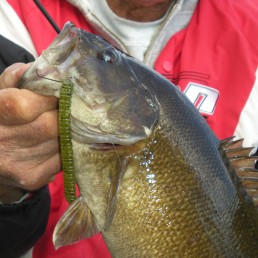The Long and Short of Fall Bass
SHARE THIS POST
While both largemouths and smallmouths are bass, they tend to make different fall pilgrimages. One’s movement is fairly short, and the other’s, much longer.
A lot of river largemouths live near deeper weed edges after spring. When fall arrives, many will move back into the shallows—maybe even back near their spring locations. Now is the time for another frog attack, near wood, weeds and other cover.
As the water cools, I look for areas that contain green weeds and are a bit deeper. Green weeds are key as they hold pretty much the whole food chain, from baitfish up to predators. One thing about weeds is that they recede from the top down. Colder water may kill off the tops, but there may still be green weeds near the base, and they may stay green all fall.
Early on, I use a mobile bait, like a shallow crankbait, in brown or baitfish patterns. Spinnerbaits are still worth their weight in bass. Single Colorado blades produce more vibration. Twin willow blades turn on the flash. Variations of white and also black are good starters. I prefer nickel/silver most of the time, but keep a bronze or gold blade with a black skirt handy, especially if the water is a little off color. A little blue in the skirt or blade is also good.
Spinnerbaits with Colorado blades work great for probing areas in fall. Reeling the bait tight to weed clumps and then letting it helicopter down toward the bottom can produce strikes, especially if the fish are not chasing. One other tip: Consider using a different blade setup. For fish that regularly see Colorado and willow blades, a switch can be the necessary magic. Trio Tackle (TrioTackle.com) has a bait that fits the bill, featuring two smaller willow blades up top and a single blade closer to the body. Sometimes, the changeup can really score.
As the water cools into October, note the water temperature. The fish will gradually move deeper. A Texas-rigged Senko can draw attention if you need to slow down. As it gets colder, deep-diving suspending baits, like the Rapala Husky Jerk or deep Shad Rap RS, fished along the deeper breakline can coax the fish to try one.
Once the fish are deeper, I turn to bass jigs with Berkley MaxScent Power Chunks or Creature Hawgs to mine the drops. A crawfish or baitfish color tube will also produce. A lot of the time, you’ll find largemouths holding close to the same areas as in summer—just deeper. Remember the green weeds.
I really enjoy river smallmouths as a fall foe when they winter in deeper holes. Whether they are native species, or fish leaving a summer feeder stream, they’ll look for water in the 20-foot depth range for winter. This can mean a fairly long journey, especially if they’re leaving a shallow feeder stream.
Are you enjoying this post?
You can be among the first to get the latest info on where to go, what to use and how to use it!
They’re mobile now and will probably stop at numerous areas that draw baitfish as they travel. Deep-diving crankbaits will cover ground and help you find fish quicker. Areas with 4 to 6 feet of water, with riprap or wood, are always good targets. They may be here today and gone tomorrow, though. A lot of times, new fish move in as other ones move out.
I like crankbaits that get down to ten feet or better. Also, if one brand stops producing over time, they may be agreeable to a different brand. I’ve no idea why, but it pays to carry a few alternatives. Brown craw, firetiger and red craw have all worked, color-wise.
When the water temp hits 48 degrees, I’ll switch to plastics. Green Pumpkin, Peanut Butter & Jelly and craw colors are tube staples, with 2 1/2- to 3 1/2-inch tubes normal sizes. Keep a louder color, like bubblegum or chartreuse, in your box. Plastics like a 4-inch Centipede (Zoom), and flukes on a lightweight (1/16-ounce) jig drifted along bottom can tempt the fish. Start looking deeper, too.
Smallmouths should be close to wintering areas by mid-Octrober. Try Senkos (4- to 5-inch) and 3/8-ounce swing jigs tipped with a Green Pumpkin Berkley Power Bait MaxScent Creature Hawg. Reel slowly across bottom, as that keeps it out of the snags, and bass can locate and pounce before it moves away. Swing jigs offer a world of possibilities, in sizes from 1/8- to 1 1/4-ounce available. I mold my own, using Do-it Molds to cover the size range. You can also vary the hook sizes when you do your own, to customize as needed.
As you fish, note where, how and on what bait and retrieve you catch fish from one spot to another, because they will probably follow the same pattern year after year. But don’t be surprised if one area that worked last year doesn’t this time. You could be between groups. Or they just aren’t using that location. That’s fishing.
Looking for some new fishing techniques to try this season? You’ll find plenty of suggestions in every issue of MidWest Outdoors. Subscribe on our website.
MWO
SHARE THIS POST
You may also like...
Nothing found.
Did you enjoy this post?
You can be among the first to get the latest info on where to go, what to use and how to use it!
Tom Luba
Tom Luba is a freelance outdoor writer living in New London, Wis. He has written about open water fishing for more than 35 years.
